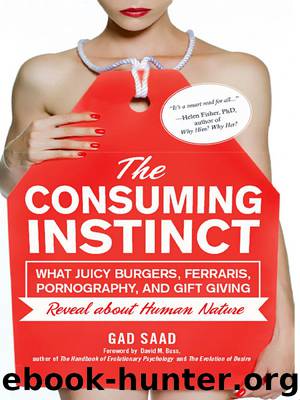The Consuming Instinct: What Juicy Burgers, Ferraris, Pornography, and Gift Giving Reveal About Human Nature by Gad Saad

Author:Gad Saad [Saad, Gad]
Language: eng
Format: epub, mobi
ISBN: 9781616144296
Amazon: 1616144297
Publisher: Prometheus Books
Published: 2011-06-20T22:00:00+00:00
Having provided an example of the power of local advertising from my own backyard, I turn next to a discussion of two advertising copy elements that are culturally determined: color connotations and language use.
Color Connotations
Colors are used extensively in marketing, be it in packaging, branding, or advertising. Most people easily recognize that Coca-Cola and Pepsi are associated with red and blue, respectively. Colors can be used to tug at our feelings (as in creating a mood via the use of colors) or to elicit cognitive associations (gold and red might be associated with prestige and passion correspondingly). Colors are associated with culture-specific holidays and occasions such as Christmas (red and green), Valentine’s Day (red), and Halloween (orange and black), all of which are replete with gift-giving implications. We typically assume that blue and pink are universal depictions of masculinity and femininity particularly. These color connotations are so ubiquitous in North America that they have become emblematic of gender socialization (blue is for boys and pink is for girls). That said, in the Netherlands, blue represents femininity.33 The professional soccer team of Palermo, which plays in the top Italian division, is famous for its pink jerseys. Clearly, then, in international advertising, a key objective is to identify which color connotations or color preferences are universal (if any) and which ones are culture-specific.34
The importance of colors is well captured in the number of idioms that utilize specific colors to convey meaning. In the English language, a partial list includes: seeing red, green with envy, tickled pink, feeling blue, clear as black and white, black sheep of the family, the company is in the red (or black), calling someone out of the blue, painting the town red, telling a white lie, being yellow-bellied, having a heart of gold, black comedies, once in a blue moon, having a green thumb, being red in the face, red tape, red carpet treatment, pink slip, and white flag. Needless to say, these color idioms are language-specific and do not necessarily translate well into other languages. For example, “black sheep” in English is equivalent to “white crow” in Russian. In addition, whereas “black sheep” is typically defined as being an outcast, it symbolizes independence in Italy.35 In Quebec French, “ma blonde” (literally translated as “my blonde”) means “my girlfriend,” even if the girlfriend is a brunette. In this case, a standard hair color is used to describe girlfriends of all races and hair colors.
Colors often become emblematic of one’s national identify via the colors of a country’s flag. Most people can probably state the colors of the Canadian and Japanese flags (both red and white) or those of the United States and France (red, white, and blue). Companies can also at times become strongly associated with specific colors; the generic term “blue chip companies” refers to financially stable and reputable firms. Owens Corning has a trademark on the color PINK (capitalized), which it uses for its insulation products (using the Pink Panther as the mascot). IBM is known
Download
The Consuming Instinct: What Juicy Burgers, Ferraris, Pornography, and Gift Giving Reveal About Human Nature by Gad Saad.mobi
This site does not store any files on its server. We only index and link to content provided by other sites. Please contact the content providers to delete copyright contents if any and email us, we'll remove relevant links or contents immediately.
| Advertising | Consumer Behavior |
| Customer Service | Marketing |
| Public Relations | Sales & Selling |
| Search Engine Optimization |
Influence: The Psychology of Persuasion by Robert B. Cialdini(4201)
The Miracle Morning by Hal Elrod(3935)
The Hacking of the American Mind by Robert H. Lustig(3601)
Pre-Suasion: A Revolutionary Way to Influence and Persuade by Robert Cialdini(3443)
Unlabel: Selling You Without Selling Out by Marc Ecko(3004)
Hidden Persuasion: 33 psychological influence techniques in advertising by Marc Andrews & Matthijs van Leeuwen & Rick van Baaren(2802)
Who Can You Trust? by Rachel Botsman(2739)
Kick Ass in College: Highest Rated "How to Study in College" Book | 77 Ninja Study Skills Tips and Career Strategies | Motivational for College Students: A Guerrilla Guide to College Success by Fox Gunnar(2728)
Ogilvy on Advertising by David Ogilvy(2712)
Purple Cow by Seth Godin(2712)
I Live in the Future & Here's How It Works by Nick Bilton(2540)
This Is Marketing by Seth Godin(2504)
The Marketing Plan Handbook: Develop Big-Picture Marketing Plans for Pennies on the Dollar by Robert W. Bly(2428)
The Power of Broke by Daymond John(2392)
Building a StoryBrand by Donald Miller(2379)
The 46 Rules of Genius: An Innovator's Guide to Creativity (Voices That Matter) by Marty Neumeier(2323)
Draw to Win: A Crash Course on How to Lead, Sell, and Innovate With Your Visual Mind by Dan Roam(2287)
The Tipping Point by Malcolm Gladwell(2214)
Market Wizards by Jack D. Schwager(2180)
